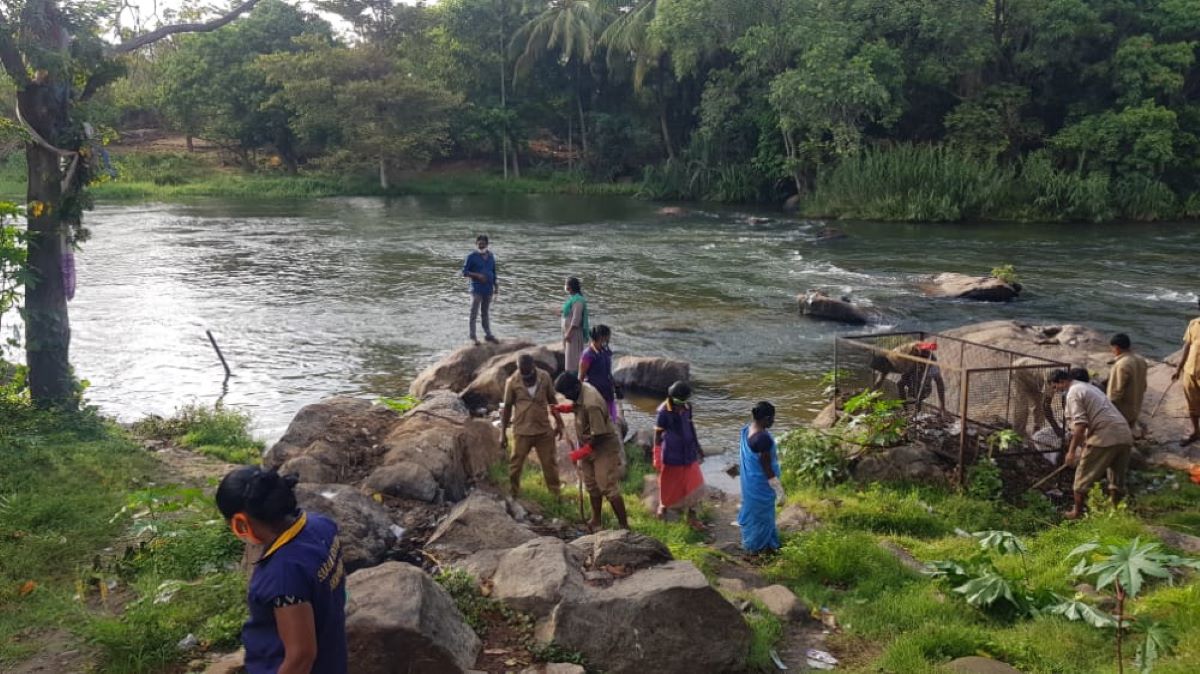The Thamirabarani is more than just a river; for the people of Tirunelveli district, it is a life-giver, it is an emotion.

The cleaning of the Thamirabarani river and the waterbodies linked to it has been an effort taken up by the people, cutting across divides of caste and religion. (Supplied)
Breaching social and religious divides, the people of Tirunelveli district in Tamil Nadu have united for a mission: Save the state’s only perennial river, the Thamirabarani, from dying a slow death.
River pollution, rapid urbanisation, sand mining, and the effects of climate change over the years have taken a heavy toll. The river has been shrinking in size over the years and is filled with unacceptable levels of industrial and human-generated waste. And the local population will have none of it.
So last year, people came together to unitedly launch a comprehensive plan — the “Nellai Neervalam” (Tirunelveli Water Resources) — that seeks to stabilise Tirunelveli’s waterbodies and its groundwater table.
“Thamirabarani is more than a river for this district, it’s an emotion,” explains Tirunelveli District Collector Vishnu Venugopal, the force behind the initiative.
“Everybody in this region identifies with it in one way or another.”
And their aim, says Venugopal, is to make its water drinkable by 2024.
There is a reason why people of the district are so passionate about the Thamirabarani: Tirunelveli’s population of about 1.6 million is largely dependent on the river.
The district falls in an agrarian belt dominated by farming activities, which perhaps explains the unique and complex interplay between the Thamirabarani, and a network of inter-linked tanks and waterbodies connected to it.
More than 1,200 waterbodies of various sizes — ranging from an acre to one about 300 acres — are situated in the district, and the river fills these through multiple channels that run parallel to it.
“These water bodies are the central defining feature of the people here,” Venugopal told South First.
“There can be only a few places in other parts of the country with so many intricacies such as Tirunelveli when it comes to the water system.”
Thamirabarani is a fabled watercourse in ancient Tamil literature with plenty of references to the river in the Sangam era. Research findings have indicated the civilisational antiquity in the region could date back to at least 3,200 years.
Recently, subterranean limestone formations and underneath caves have been discovered in the region — which is found to help avert flooding and keep the groundwater levels stable.
Yet, despite the availability of such rich water resources, the region struggles for water security for both agriculture and household needs.
As part of Nellai Neervalam’s first leg, all the 1,200-plus water bodies are digitally mapped containing details of their size, boundaries, and jurisdiction. The living digital database of flora and fauna — available in the public domain — is among the first of its kind in the entire country.
The programme also involves digital tree mapping to gather data like height, girth, birds’ nesting patterns, and potential threats to trees.
Secondly, local volunteers are drafted into conservation measures and flood-handling efforts. Over 650 young volunteers have signed up to take part.
Funds are mobilised through multiple sources — the corporate social responsibility (CSR) programmes of companies and from affluent individuals from the neighbouring villages.
“Some of them are keen to rejuvenate lakes from their native villages. They can pick and choose,” Venugopal said.
For technical support, the Bengaluru-based not-for-profit biodiversity research organisation Ashoka Trust for Research in Ecology and The Environment (ATREE) and the multi-city conservation group Environment Foundation of India have lent resources.
Dozens of tanks have already been cleaned, desilted, and restored since last year, while some 75 more are being renovated as the northeast monsoon fully sets in.
About 50 irrigation tanks — which remained parched for decades due to encroachment — have now received water after the obstacles were removed.
A series of gatherings called Nellai Neervalam dialogues routinely take place with participation from environment and water conservation experts. A specially curated and hyper-local content is created for school children to create awareness about water-related activities in the region.
Rallies and storytelling events are also organised. Tales about Thamirabarani, its tributaries, and temples of cultural significance are narrated to children and interactive sessions are conducted by professional storytellers.
A special system to convert water hyacinth — a major menace in water bodies — into fertiliser, paper, and handicrafts has been put in place.
A dedicated yet simple mobile app allows urban residents to register their complaints of flooding in two simple steps: They need to fill in information on the exact location of the inundated streets, and the flooding levels – i.e. whether up to the ankle, knee, waist or neck.
In 2021, the team received over 350 complaints regarding heavy flooding, of which 80 percent were addressed.
Some of the major causes of pollution in this region are due to vehicle washing, open defecation, littering after gatherings, and plastics.
“In one stretch along Thamirabarani, Nellai Neervalam’s volunteers removed a five km-long encroachment,” ATREE’s senior researcher Mathivanan told South First.
Alongside, the digital tree mapping has helped researchers identify native trees that are declining in the region. “We have been planting various native species,” Mathivanan added.
However, the team admits sustained efforts are required to transform the water ecosystem of the Tirunelveli region.
“This is still a work in progress,” Venugopal admitted.

Apr 18, 2024

Apr 18, 2024

Apr 18, 2024

Apr 18, 2024

Apr 17, 2024